We’ll explore how PIM for fashion industry improves product information management and drives business success.
In the fast paced fashion world, providing clear, accurate, and up to date product details is crucial.
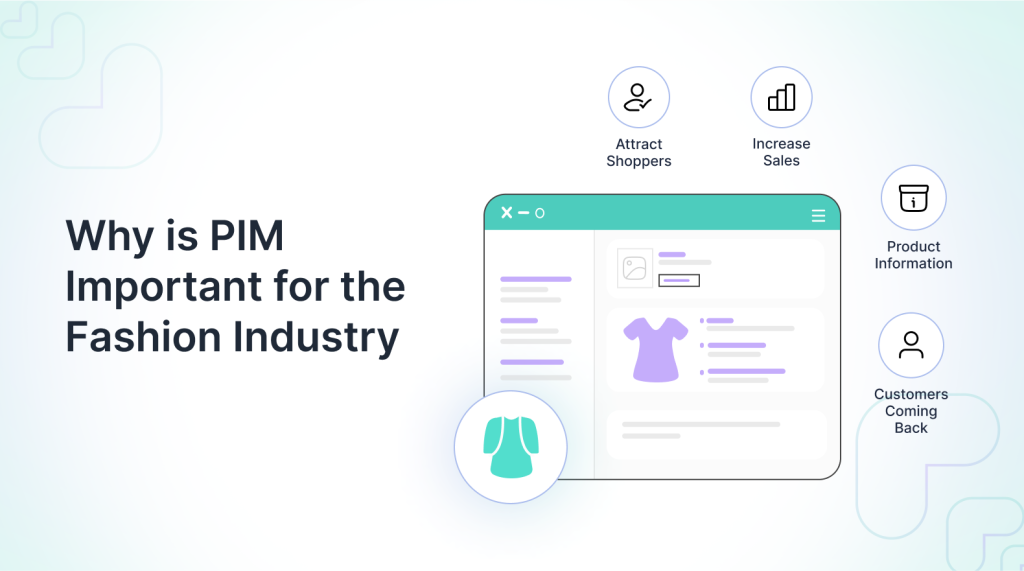
Trends and what customers like can change really fast, so providing the right info can help draw in shoppers, increase sales, and create loyalty.
Wrong information can lead to lost sales and harm a brand. Accurate details help customers make better choices and improve the shopping experience.
In this competitive market, fashion and apparel brands must manage their product data effectively.
Having a strong and top PIM solutions is really important for doing well in business.
What is Product Information Management (PIM)?
PIM Software focuses on gathering, organizing, and distributing product details. It helps keep everything uniform across various channel and marketing platforms.
Product Information Management system brings together all the details about a product, like its features, prices, descriptions, pictures, and videos, into one place.
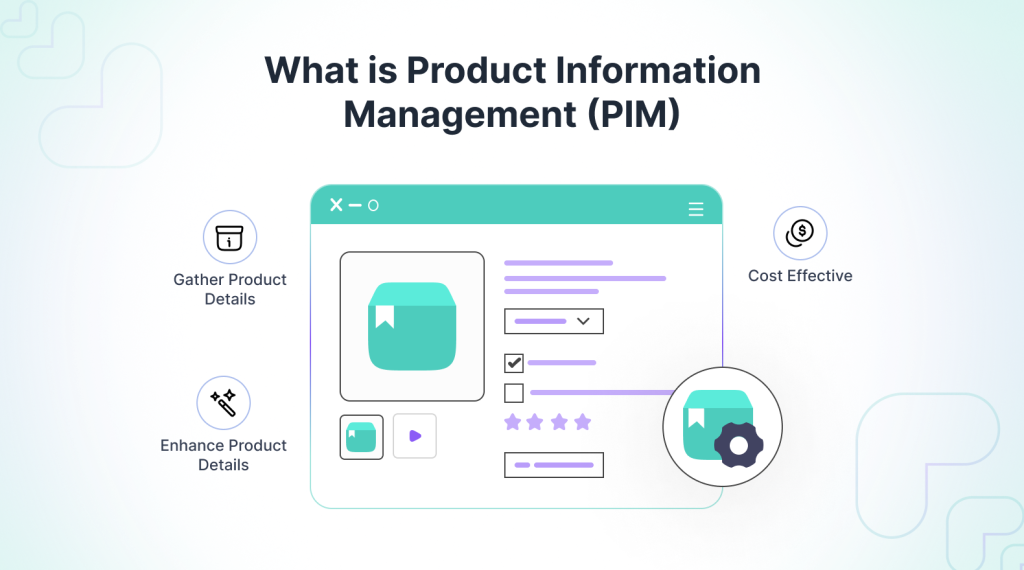
This makes it easier for businesses to handle their product data. Fashion retailers really need the best PIM solutions to make sure their data is correct.
This helps create a seamless shopping experience for customers on every platform.
PIM for apparel and accessories solutions play a crucial role in the fashion retail industry.
They assist businesses in organizing and handling all their product information effectively. No matter if you choose an open source or SaaS PIM solution.
Fashion and apparel brands manage their product information in a rapidly changing industry where products and styles come and go with the seasons.
Importance of PIM For Fashion and Apparel eCommerce
The fashion retail world is going more digital every day. Lots of people are choosing to shop online and connect with brands through different online platforms.
According to Statista, global fashion eCommerce sales will go over 781 billion U.S. dollars by 2024. This highlights the rapid growth of the industry.
As the market gets bigger, shoppers want more personalized and easy shopping experiences.
This has made it super competitive for fashion retailers, who need to keep up with these changes.
Retailers must use smart systems to manage product information and ensure a seamless shopping experience.
This is essential for keeping customers happy.
Unique Challenges of Fashion Businesses
Fashion retailers deal with a lot of special problems that make it hard and take a long time to manage product information.
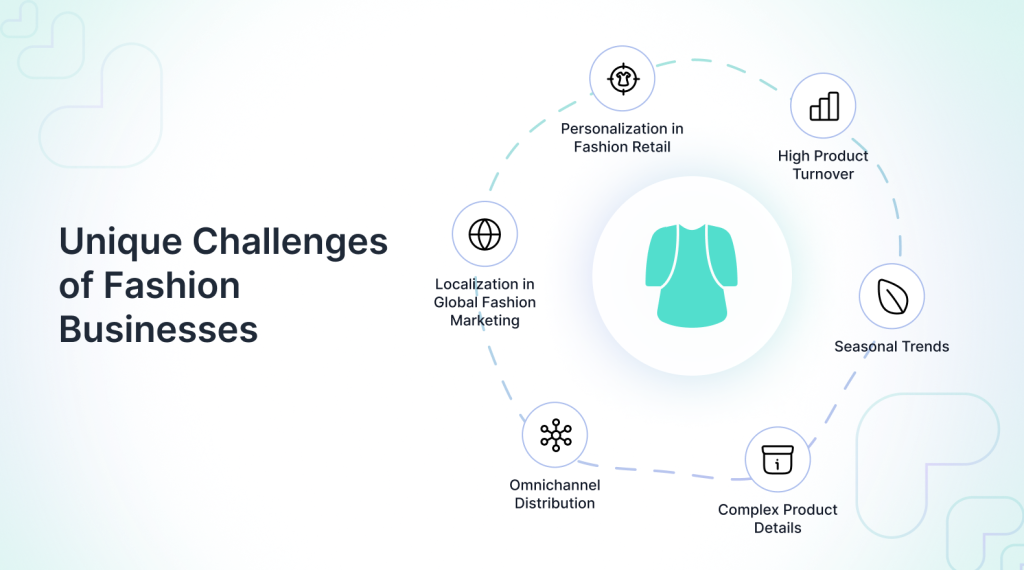
High Product Turnover:
Fashion collections change a lot, with new items coming out all the time. It’s really important to keep product information correct and current.
This helps prevent customers from getting confused or leaving their shopping carts.
Seasonal Trends:
Fashion goes in cycles, with new collections coming out for different seasons and trends.
This means that stores need to constantly update their, product descriptions, and pictures.
Complex Product Details:
Fashion items need clear descriptions that show sizing charts, what the fabric is made of, how they fit, and how to take care of them.
It’s important that all this information is easy to understand, matches up well, and is current.
Omnichannel Distribution:
It’s really important for businesses to maintain a smooth and consistent shopping experience.
This is crucial for customers using different platforms, like websites, mobile apps, online marketplaces, and social media.
This helps to keep customers loyal and happy.
Localization in Global Fashion Marketing:
Fashion brands that sell their products all over the world need to change their information to fit different markets.
This means they must translate their content into the local languages, use the correct currencies, and adjust sizes to meet regional expectations.
Additionally, brands should pay attention to local laws, rules, and cultural tastes when they promote their products in various places.
Personalization in Fashion Retail:
Nowadays, shoppers want their shopping experiences to feel special and unique.
This means that stores need to customize what they recommend, the deals they offer, and how they market their products to match what each person likes.
However, keeping track of personalized content while also providing correct product details can be tough.
It takes a lot of careful study of customer information to get it right.
Role of PIM in Fashion Retail
Fashion products can be complex due to the variety of sizes, colors, and materials, plus trends change rapidly.
PIM for apparel and accessories systems are super helpful for fashion retailers to handle all this complexity by:
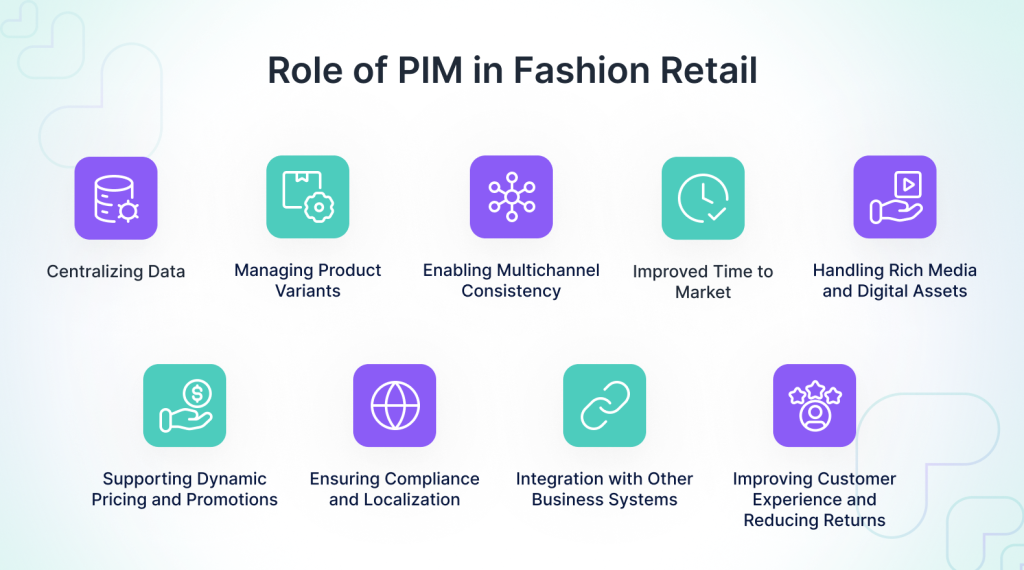
Centralizing Data:
A PIM system centralizes all product information. This includes images, prices, descriptions, and weight, all in one place.
This helps get rid of separate data storage, making sure everything is consistent across different departments.
It also allows for quick access and updates, which means products can be launched faster and operations run more smoothly.
Managing Product Variants:
Fashion items usually have different colors, sizes, and styles. Product Information Management system helps shops keep track of the differences between products.
It makes sure that all the details about the products are accurate and complete.
This helps avoid mistakes and guarantees that customers can see all the choices available to them.
Multichannel Consistency:
PIM systems help keep product information the same everywhere, whether it’s on websites, in apps, or in physical stores.
This makes shopping easier for customers, no matter where they are buying, and it builds trust in the brand while making customers happy.
Rich Media and Digital Assets:
Fashion retail relies on high quality images and videos to showcase products.
PIM systems team up with DAM (Digital Asset Management) to sort out media assets such as 360-degree images and style guides.
This helps make sure that the right visuals connect to each product version, which improves the experience for customers.
This enhances the shopping experience and reduces return rates due to misleading product visuals.
Improved Time to Market:
Fashion is changing super fast, so stores need to keep up quickly.
PIM systems make it easier to enter and update information, which helps them launch new products and update their stock faster.
This quickness allows stores to follow trends and seasonal shifts, giving them an edge over their rivals.
Dynamic Pricing and Promotions:
Fashion prices can change a lot because of how popular something is, special sales, or the time of year.
PIM systems help keep track of these price changes and promotions instantly everywhere.
This way, prices stay the same, and customers don’t get annoyed by different prices.
Compliance and Localization:
For international retail, PIM helps with localization. It keeps product information in various languages and adjusts size charts for different regions.
Also makes sure that local laws are followed. It assists stores in handling their global activities while ensuring that product details stay the same.
Integration with Other Business Systems:
PIM systems usually work together with other business systems like PIM for CMS, ERP, and eCommerce platforms.
This teamwork helps product information move smoothly between these systems. It gives everyone in the company a clear and consistent view of the product.
Improving Customer Experience and Reducing Returns:
When customers have clear product information, such as specific size charts and material descriptions.
They can make more informed buying decisions.
This helps to lower the chances of buying the wrong item and having to return it, which makes customers happier and more likely to come back.
Selecting Best PIM for Fashion and Apparel Brands
Choosing the right PIM solution for your fashion business requires some serious thought.
You should think about what your company truly needs and what goals you want to reach.
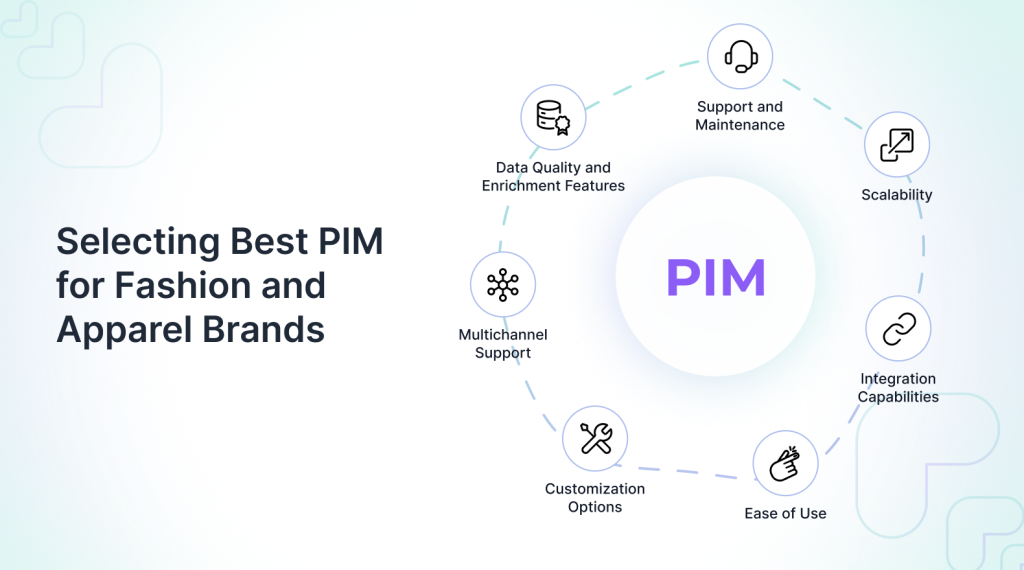
When choosing the best PIM for fashion retail, there are several factors to consider:
Scalability
Is the PIM able to grow with your business as you add more products or move into new markets?
It needs to handle more data without slowing down, so it stays useful for your fashion business as it changes over time.
Integration Capabilities
Is the PIM easy to connect with your current eCommerce platform like PIM for Shopify, ERP system, and other apps you use?
When everything works well together, it helps make your work easier. It keeps your data accurate and improves how well the whole system runs on all platforms.
Ease of Use
Is the system easy enough for your teams to start using without needing a lot of training?
A user friendly interface can really reduce the time needed for training.
It makes it easier for more people to use, which helps in handling product data more smoothly and efficiently.
Customization Options
Can the PIM be customized for fashion related details like different fabric types, color samples, and size charts?
Being able to adjust the system to fit your specific product features makes sure that your fashion catalog is shown correctly.
Multichannel Support
Does the PIM support multiple channels, like online stores, marketplaces, physical retail locations, and social media?
Keeping your product information the same and current everywhere customers interact with it is really important.
This helps create a smooth experience for customers, no matter how they shop.
Data Quality and Enrichment Features
Does the PIM provide features to enhance and check your product information?
Having accurate, detailed product information, along with engaging media like pictures, videos, and specifications.
This boosts the shopping experience. It also helps minimize mistakes and improves customer satisfaction.
Support and Maintenance
Is the PIM provider good at helping customers and keeping things running well?
Getting quick help from tech support and receiving regular system updates is super important.
This will make sure your PIM runs smoothly and can change as your business expands.
Future Trends in PIM for Fashion
As technology keeps getting better. The future of Product Information Management (PIM) in fashion retail is set for some really cool changes.
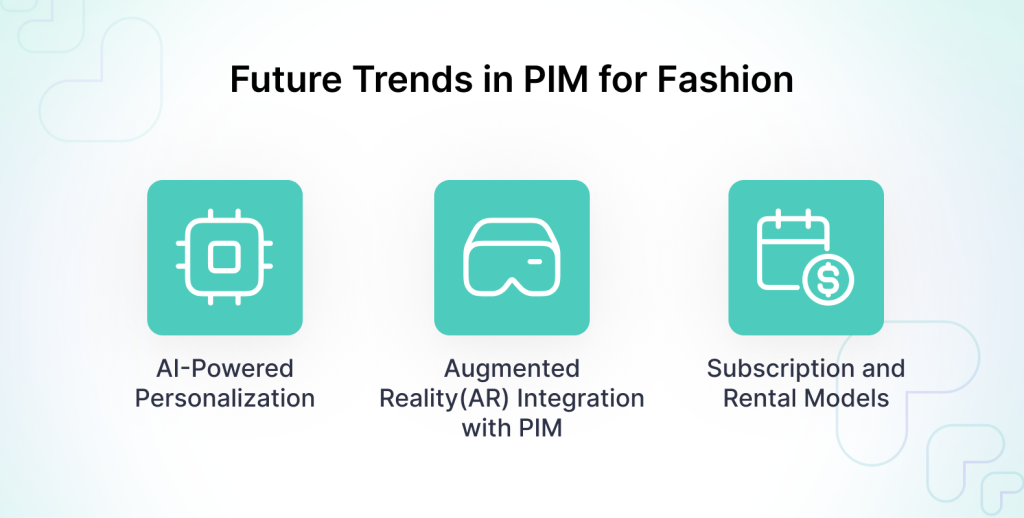
Some new trends we can expect are:
AI-Powered Personalization:
With the help of artificial intelligence, clothing stores can offer custom product suggestions.
AI generated content matches what each customer likes and how they shop.
Subscription and Rental Models
Fashion brands moving towards subscription or rental models will use best PIM systems for fashion industry to manage complex product data.
This includes rental schedules, membership benefits, and customer preferences.
This will make managing products easier and enhance the overall experience for customers.
Augmented Reality (AR) Integration with PIM
AR puts digital pictures of products right on top of what you see in the real world, helping customers see how things will look as they shop.
When AR is combined with best PIM for fashion industry, it ensures that product information is accurate.
This enables exciting features like virtual try ons and style tips, making shopping more fun and engaging.
Conclusion
In the fast moving world of fashion, having the right PIM for fashion and apparel eCommerce is super important for doing well.
PIM solutions help fashion brands organize their product details. They make sure everything is correct and consistent across all selling platforms.
Whether you need a free PIM for fashion industry or the best PIM for fashion retail, choosing the right system.
It can help you create a smooth shopping experience, meet what customers want, and stay ahead of your rivals.
By handling product information well, fashion businesses can work more efficiently.
This cuts down on mistakes and gives customers a better shopping experience, helping them grow and build brand loyalty.


Be the first to comment.